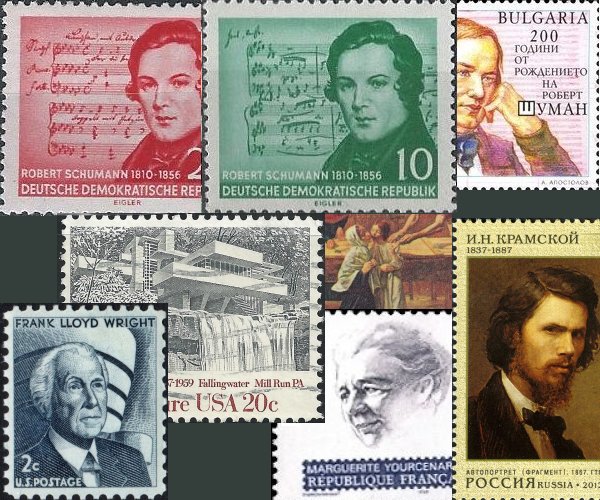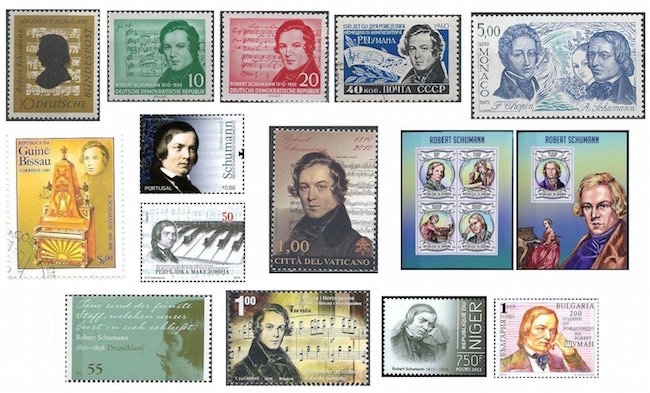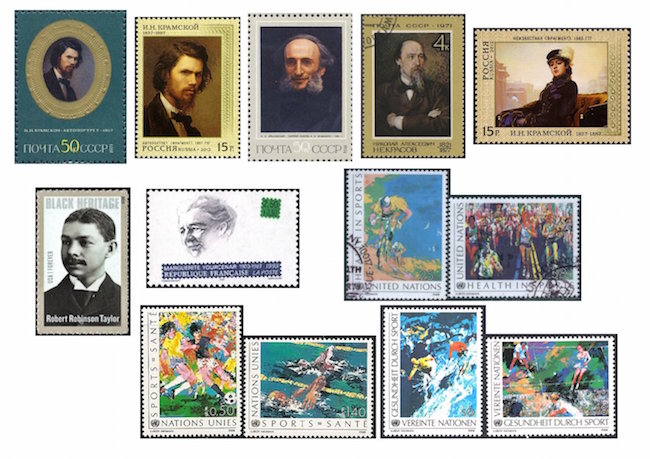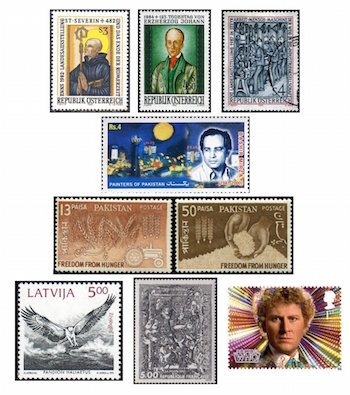The Arts on the Stamps of the World — June 8
An Arts Fuse regular feature: the arts on stamps of the world.

By Doug Briscoe
Today is the 150th anniversary of the birth of Frank Lloyd Wright, and we celebrate the birthdays of Robert Schumann, John Everett Millais, Marguerite Yourcenar, and many—yes, many—more.
I present my complete Robert Schumann (1810 – 29 July 1856) stamp collection along with two bicentenary issues (from Bulgaria and Macedonia) and an odd pair of souvenir sheets from Burundi that I still haven’t acquired. The first Schumann stamps to appear were issued by the two Germanies for his centennial in 1956. If you look carefully at the two GDR stamps (green and red), you’ll note that they show different music, which leads me to the immortal question, “What’s wrong with this picture?” (Answer below.) In 1960 the Soviet Union produced a nice design quoting “Träumerei” from “Kinderszenen.” In 1985 both Monaco (upper right) and Guinea-Bissau (second row left) came out with stamps honoring Schumann; the former pairs him with Chopin for the 175th anniversaries of their births in 1810, and the latter comes from a set of stamps of eight different composers whose significant birth or death anniversaries all occurred in 1985. Other than a large composer collection issued by Grenada Grenadines in 1996 (not shown), there were no more Schumann stamps until the bicentenary six years ago, at which time we got a flurry of them. The Bulgarian stamp, lower right (I also included it in the header image so you can see it more clearly), boasts an ingenious design feature. In Bulgarian Cyrillic, as in Russian, the sound we English speakers represent as “sh” is indicated by a single letter, ш, pronounced “sha”. This sound is the same as that for German “sch”, as in Schumann, and French “ch”, as in Chopin. If you look at the composer’s name, at middle right on the stamp, you’ll see that the designer has cleverly used an image of the piano keys C through E as a pictorial substitute for the Cyrillic letter ш! The Chopin stamp (not shown) used the same device. What an inspired idea!

The error in the East German stamps is that in the original issue of July 1956—the 20 pfennig value in red—the music to the left of the portrait is not by Schumann, but rather by Schubert! A corrected version, the 10 pfennig green value, was issued about two months afterward. I can’t smugly smirk and point fingers, because I never would have caught it myself and in fact cannot identify either of the pieces shown. Can you? I described the Burundi sheets (shown second row right at reduced scale) as “odd” because they have even more egregious errors: the lower left 3000f and the 7500f values are based on portraits of…Beethoven! I’m not sure about the 1190f value, which looks like Mendelssohn.
I suppose that, if asked, the paradigmatic “Man in the Street” would be able to name exactly one architect, American or otherwise, Frank Lloyd Wright (June 8, 1867 – April 9, 1959). We have much ground to cover today, so, as an Icon with a capital I, Wright will perhaps forgive me if I simply point out that his three US stamps date from 1966 (the portrait definitive with the Guggenheim Museum in the background), 1982 (Fallingwater, part of an architectural series), and an unexpected view of the Guggenheim (2005, from a Modern Architecture souvenir sheet). A fourth stamp, from Togo, gives us an external view of the museum.
One of the founders of the Pre-Raphaelite Brotherhood (whose work collectively I personally so dearly love [note to self: too many adverbs]) was Sir John Everett Millais (1829 – 13 August 1896). A set of stamps depicting his art was issued in 1979 by the Isle of Jersey for the sesquicentennial of his birth. Three of these are My First Sermon (1862-63), The Two Princes Edward and Richard in the Tower (1878), and Christ in the House of His Parents (1850). I can’t identify the second stamp of the group, the 10½p denomination of the little girl standing outdoors. Any help? The stamp from Niger shows Millais’s Ophelia (1852), a poster of which I’ve had on my wall for years, right next to one of his Mariana (1851). Finally, an unexpected discovery comes in the form of a 1975 Bulgarian stamp showing a Millais etching, Mother Feeding Child.

Englishman John Smeaton (8 June 1724 – 28 October 1792) is sometimes called the “father of civil engineering”. He built, among other things, bridges, canals, and lighthouses. It is one of these last that was his signal accomplishment. Sometimes called Smeaton’s Tower, the Eddystone Lighthouse (1755-59) replaced two earlier structures that had been destroyed by a storm (1703) and a fire (1755). Smeaton introduced a number of innovations in the lighthouse’s construction, one of which was his invention of “hydraulic lime”, a concrete that fixes underwater. Though the tower still exists, it was no longer used as a lighthouse after 1879. The structure is twice mentioned by name in Melville’s Moby Dick (chapters 14 and 133), appeared on British penny coins (1860-94 and 1937-67), can be seen in the background of a portrait of Smeaton by the American painter Mather Brown, and is the subject of a New Zealand stamp issue of 1947. Why New Zealand? you may ask. Because the stamp, for official use by the government’s Life Insurance Department only, made use of a symbol that represented unshakable long-term stability. The story of the building of the lighthouse has been reimagined in a 2005 novel, Smeaton’s Tower, by Christopher Severn. Smeaton, by the way, who designed many other projects, was also a noted physicist.
The Spanish novelist, essayist, and critic José Augusto Trinidad Martínez Ruiz (June 8, 1873 – March 2, 1967) is better known by his pen name Azorín. He started out writing literary criticism and radical leftist political pieces for newspapers. Very soon, however, he began to adopt a more conservative viewpoint, marked by nationalism, a delving into Spanish history, and a certain nihilistic pessimism. This reassessment evinced itself in such books as The Castilian Soul and The Route of Don Quixote. His first novels (1902ff) were pointedly autobiographical, and it was with these works that he began using the pseudonym Azorín, taken from one of his characters. He wrote his first play many years later, in 1926. At around this time, well before the coming of the Spanish Civil War, Azorín had reverted to his more progressive inclinations. He left Spain for Paris in 1936, but in order to return in 1939 was compelled to make accommodations with the Franco regime. He added film to his repertoire of criticism in his later years, making what for him must have been a remarkable statement, “Cinema is the greatest form of art.”
The Russian painter and art critic Ivan Nikolaevich Kramskoi (June 8 [O.S. May 27], 1837 – April 6 (O.S. March 24), 1887) left us a string of portraits of prominent Russians: writers, scientists, and other artists. Some of these we have already seen in our tributes to those individuals, such as Mikhail Saltykov-Shchedrin (portrait of 1879). For today, we see Kramskoi’s Self portrait of 1867 on two Russian stamps, the earlier of them (1971) from the Soviet Union, the more recent issued just five years ago. Next are his portraits of painter Ivan Aivazovsky and poet Nikolay Nekrasov, both of whom have birthdays later in the year (Aivazovsky’s is next month); and finally, an unfinished and untitled portrait of an unknown (?) woman from 1883. As a student at the St. Petersburg Academy of Arts he was one of those who instigated the “revolt of fourteen”, as a result of which a number of rebellious young artists were expelled and went on to form the Artel of Artists and then the Peredvizhniki, which we have referred to as recently as the day before yesterday in connection with another of its members, Konstantin Savitsky. Apart from portraiture, his most famous work is Christ in the Desert (1872).

The groundbreaking Robert Robinson Taylor (June 8, 1868 – December 13, 1942) was the first African-American to be admitted to the Massachusetts Institute of Technology (1888) and would become the first accredited African-American architect. It was at MIT that Taylor met Booker T. Washington, who invited him to come to Tuskegee University as a teacher/administrator and to design additional buildings for the campus. These would include Science Hall (Thrasher Hall, 1893), Tuskegee Chapel (1895-98), and the president’s residence The Oaks (1899). Following a period in Cleveland he returned to Tuskegee until his retirement. In the meantime he also designed Carnegie libraries at Wiley College in Marshall, Texas, and at Livingstone College in Salisbury in his native North Carolina, among others. His stamp was just issued in 2015.
Marguerite Yourcenar (1903 – 17 December 1987) is surely best known for her unforgettable Memoirs of Hadrian (1951), but she wrote a great many more books than that one. She was born in Brussels with the name—hold on to your hats—Marguerite Antoinette Jeanne Marie Ghislaine Cleenewerck de Crayencour. Her mother died ten days after Marguerite’s birth, and the girl was brought up by her paternal grandmother in Lille. Her first published work was printed under the name Yourcenar, almost but not quite an anagram of Crayencour, and her first novel, Alexis, written under the influence of Gide, came out in 1929. She met her life partner, the American literary scholar Grace Frick, in 1937; the pair fled World War II for the United States in 1939, first Connecticut, then Maine, where they cohabited for the rest of their lives. Yourcenar adopted American citizenhip in 1947. In 1980 she was the first woman to be elected to the Académie française.

American artist LeRoy Neiman (born Leroy Leslie Runquist, June 8, 1921 – June 20, 2012) was perhaps most noted for his sports paintings, and so it’s not surprising that he was commissioned to do a set of pieces for six “Health in Sports” stamps issued by the United Nations in 1988. The UN has issued its own postage for its New York headquarters from shortly after the organization’s founding, and the Geneva and Vienna offices started issuing their own stamps in 1969 and 1980 respectively. Sometimes the designs are identical to the New York versions, except for the denominations and languages; in other instances different designs are used, as was the case with the Neiman set.
We turn now to three artists who have been active in stamp design, albeit by no means exclusively, Mayr, Mirza, and Mörck. The Austrian Friedrich Mayr (born 8 June 1929 as Friedrich Weingartner) is also an engraver who has designed medallions, etc. As a sample of his philatelic work, we see three of his projects for the Austrian postal service: St. Severin (1982), Archduke John (1984), and an exhibition on Work–Man–Machines that was held in 1987.
Bashir Mirza (June 8, 1941 – June 5, 2000) was celebrated as one of ten distinguished Pakistani painters in a set from 2006. Each stamp shows the artist with one of his or her works. I’ve not been able to identify the one by Mirza. Karachi’s very first art gallery, Wikipedia says, was opened by Mirza in 1965; it closed in 1969, but he opened another many years later, not long before his death. Mirza explored a number of styles during his artistic career, though on the basis of what’s showing online, this one, for which I cannot find a title or date, seems strongly representative. Yet this Untitled piece also comes from Mirza’s hand. He also designed at least one pair of stamps, in which still further variability of style is on display: the 1963 pair is on the subject of Freedom from Hunger. More of his work can be seen here.
Our third stamp artist is the Norwegian engraver Martin Mörck (born 8 June 1955). A word of clarification: Mörck has engraved, not necessarily designed, stamps, banknotes, etc. A native of Gothenburg, Sweden, he came from a family of artists, his mother in textiles, his father a graphic designer. While still quite young he became an apprentice engraver at the Swedish postal service. His first issued work, however, was this tawny owl of 1992. If his debut was somewhat delayed, he has certainly made up for lost time with the creation of over 600 further engravings for postage stamps of the Scandinavian countries, France, Monaco, Canada, and others. Some of these have already shown up in these pages, for example, the Danish stamp honoring architect Jørn Utzon. Much more of Mörck’s output can be seen at his Website.
French artist François Rouan (born 8 June 1943), who works in paint, photography, and video, comes from Montpellier. Very much an experimenter, Rouan began creating pieces using a technique of tressages (braidings or plaitings) on canvas way back in the mid-1960s. I’m guessing that this process was used in his Volta faccia of 1983, seen on the 1991 French stamp. He began exploring the possibilities inherent in photography in 1987, in film in 2005, combining these with his original paintings in ever more innovative ways. For a sampling of more of his work, see Wikiart.org.
It’s been a while since we’ve greeted another Doctor Who. This time it’s Colin Baker, like François Rouan, born 74 years ago today. The English actor was the sixth one to take on the ever-morphing role, portraying the good doctor from 1984 to 1986. Baker has had a long career on stage and television, with occasional excursions into film. British audiences also know him from the BBC series The Brothers (1974-76).
Just a mention of one more person of note born on June 8: science fiction pioneer John W. Campbell Jr. (1910 – July 11, 1971).
A graduate of the University of Massachusetts with a B.A. in English, Doug Briscoe worked in Boston classical music radio, at WCRB, WGBH, and WBUR, for about 25 years, beginning in 1977. He has the curious distinction of having succeeded Robert J. Lurtsema twice, first as host of WGBH’s weekday morning classical music program in 1993, then as host of the weekend program when Robert J.’s health failed in 2000. Doug also wrote liner notes for several of the late Gunther Schuller’s GM Recordings releases as well as program notes for the Boston Classical Orchestra. For the past few years he’s been posting a Facebook “blog” of classical music on stamps of the world, which has now been expanded to encompass all the arts for The Arts Fuse.

I’ve read elsewhere it’s Schubert: Wanderers Nachtlied and Schumann: Mondnacht
Dear Sir,
The second stamp in Jersey set, face value 10,5 pence, that was issued in 1979, is called Orphans. I have SG catalogue. It has SG number 222. Sincerely, Zvezdan from Serbia